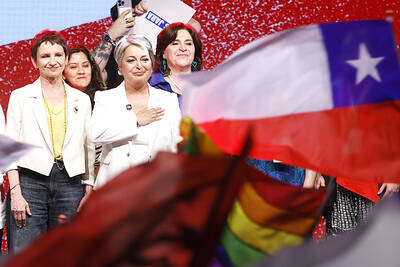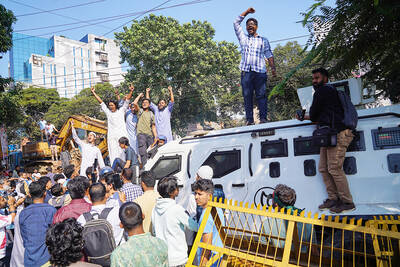US Vice-President Dick Cheney's long-held suspicion that China is a key strategic threat to the US may have been reinforced by his first official visit to that country last week, experts say.
When Cheney entered office more than three years ago ago, he viewed the problem of managing China's rapid rise as the single most important US foreign policy challenge in the 21st century.
Cheney, one of the most powerful vice presidents in US history and who exerts a quiet but strong influence on US foreign policy, may have sounded very upbeat about US-China ties during his three-day visit to Beijing and Shanghai.
But it was clear from the subtext of his speeches that he was not conciliatory on the Taiwan issue, was reserved on praise for China's recent legislation on counter-proliferation regulations and less than impressed by China's reaction to US evidence about North Korea's growing nuclear arsenal, said John Takcik, a China expert at the Washington-based Heritage Foundation.
"My feeling is that Cheney returned from China with his sense of frustration with China still fresh," said Takcik, a former 23-year veteran of the US Department of State.
He said he was "struck" that Cheney was not as effusive in his praise of China's cooperation in either the war on terror or resolving the North Korean nuclear turmoil as perhaps previous administration figures had been.
"My sense is that he continues to see China as a major challenge," Takcik said. "But again there is no percentage in raising tensions with the Chinese when we still have a number of other issues which are more pressing right now."
Takcik believes that Cheney's trip might prod the Bush administration to begin a "whole reappraisal" of its China strategy.
"The real challenge for the United States is how do we deal with an East Asia which is coming increasingly under China's political sway," Takcik said.
Derek Mitchell, an Asian affairs expert at the US Center for Strategic and International Studies, said Cheney's fundamental assessment that China would be a rival and competitor with the US in the future could not have changed after his trip.
Mitchell said US focus on China was diverted after the Sept. 11, 2001 terror attacks in the US, which led to a Washington-led global war on terrorism and wars in Iraq and Afghanistan.
But the Bush administration did not believe China was going to be a friend or partner forever, he added.
"We went from viewing China before 9/11 as being a prime part of the problem and into becoming after 9/11 an important part of the solution to international problems," he added.
Mitchell said Taiwan could top any review of Washington's China policy following Cheney's return at the weekend.
"I think they are looking at how to deal with China in the context of Taiwan and how to get China to be more flexible and more creative to create better conditions for stability across the Strait," he said.
During his China trip, Cheney had been blunt on Taiwan, stressing that the US would continue supplying weapons to Taiwan.
"The central message that Cheney said on the Taiwan issue was that our arms relationship with Taiwan is a direct function of this threat posed by China and since that threat is clearly increasing, our arms relationship and defense commitments to Taiwan concomitantly increases," Takcik said.

DISASTER: The Bangladesh Meteorological Department recorded a magnitude 5.7 and tremors reached as far as Kolkata, India, more than 300km away from the epicenter A powerful earthquake struck Bangladesh yesterday outside the crowded capital, Dhaka, killing at least five people and injuring about a hundred, the government said. The magnitude 5.5 quake struck at 10:38am near Narsingdi, Bangladesh, about 33km from Dhaka, the US Geological Survey (USGS) said. The earthquake sparked fear and chaos with many in the Muslim-majority nation of 170 million people at home on their day off. AFP reporters in Dhaka said they saw people weeping in the streets while others appeared shocked. Bangladesh Interim Leader Muhammad Yunus expressed his “deep shock and sorrow over the news of casualties in various districts.” At least five people,

LEFT AND RIGHT: Battling anti-incumbent, anticommunist sentiment, Jeanette Jara had a precarious lead over far-right Jose Antonio Kast as they look to the Dec. 14 run Leftist candidate Jeannette Jara and far-right leader Jose Antonio Kast are to go head-to-head in Chile’s presidential runoff after topping Sunday’s first round of voting in an election dominated by fears of violent crime. With 99 percent of the results counted, Jara, a 51-year-old communist running on behalf of an eight-party coalition, won 26.85 percent, compared with 23.93 percent for Kast, the Servel electoral service said. The election was dominated by deep concern over a surge in murders, kidnappings and extortion widely blamed on foreign crime gangs. Kast, 59, has vowed to build walls, fences and trenches along Chile’s border with Bolivia to

DEATH SENTENCE: The ousted leader said she was willing to attend a fresh trial outside Bangladesh where the ruling would not be a ‘foregone conclusion’ Bangladesh’s fugitive former prime minister Sheikh Hasina yesterday called the guilty verdict and death sentence in her crimes against humanity trial “biased and politically motivated.” Hasina, 78, defied court orders that she return from India to attend her trial about whether she ordered a deadly crackdown against the student-led uprising that ousted her. She was found guilty and sentenced to death earlier yesterday. “The verdicts announced against me have been made by a rigged tribunal established and presided over by an unelected government with no democratic mandate,” Hasina said in a statement issued from hiding in India. “They are biased and politically motivated,” she

It is one of the world’s most famous unsolved codes whose answer could sell for a fortune — but two US friends say they have already found the secret hidden by Kryptos. The S-shaped copper sculpture has baffled cryptography enthusiasts since its 1990 installation on the grounds of the CIA headquarters in Virginia, with three of its four messages deciphered so far. Yet K4, the final passage, has kept codebreakers scratching their heads. Sculptor Jim Sanborn, 80, has been so overwhelmed by guesses that he started charging US$50 for each response. Sanborn in August announced he would auction the 97-character solution to K4